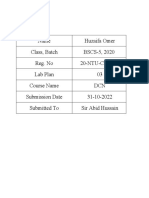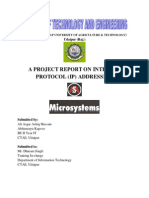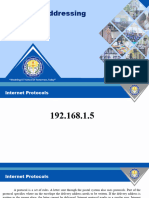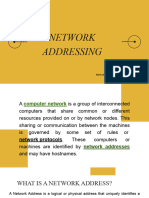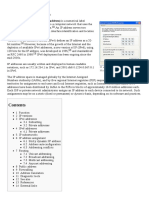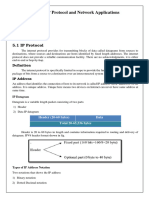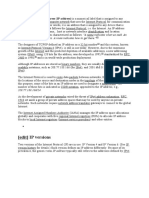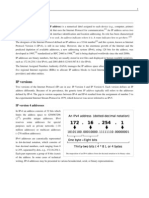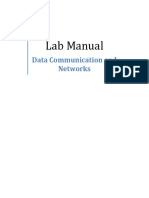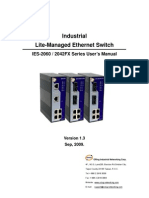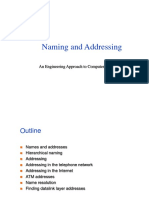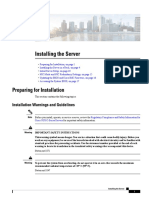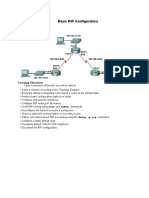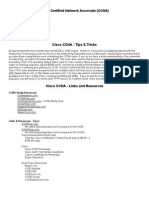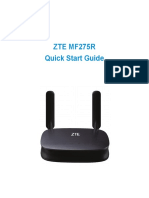CCN - Lab - 05. & 06
CCN - Lab - 05. & 06
Uploaded by
Zeeshan FarooqCopyright:
Available Formats
CCN - Lab - 05. & 06
CCN - Lab - 05. & 06
Uploaded by
Zeeshan FarooqOriginal Title
Copyright
Available Formats
Share this document
Did you find this document useful?
Is this content inappropriate?
Copyright:
Available Formats
CCN - Lab - 05. & 06
CCN - Lab - 05. & 06
Uploaded by
Zeeshan FarooqCopyright:
Available Formats
Lab Manual
Data Communication and
Networks
Lab # 5& 6
Lab Instructor :Engr. Mirza Ahsan Ullah
UNIVERSITY OF GUJRAT, FACULTY OF CS&IT
SOFTWARE ENGINEERING DEPARTMENT
IP Address
An Internet Protocol (IP) address is a numeric label consisting of a 32 bit number assigned to a network
capable device that uses IP for communication. The address fundamentally serves two purposes:
location addressing and computer host or network interface identification. The address indicates where
the connected device resides with the majority of hosts/devices still using the IPv4 (Internet Protocol
Version 4) form of addressing. A significant limitation of the legacy IPv4 addressing is that it supports
less than 4.3 billion total addresses. Based on the rapid growth of the Internet and related technologies,
the use of IPv4 is not sustainable for the long term. In the mid-1990’s, the new IPv6 technique was
developed which makes use of 128 bits for the IP address. IPv6 technology continues to be deployed,
albeit slowly. The Internet Assigned Numbers Authority (IANA) is responsible under the IETF for
management of the IP address space allocation globally. Beneath the IANA, there are five regional
Internet registries (RIRs) that are responsible for allocating IP address blocks to Internet service
providers (ISPs) and other trusted organizations.
IP Address Classes
There were five IP address classes in use before the majority of industry switched to classless routing.
There were A, B, C, D, and E. Class A addresses were used for networks with a very large number of total
hosts. Class B was designed for use on medium to large networks, and C for small local area networks
(LANs). Class D and E were set aside for multicast and experimental purposes. In the following table, the
four octets that make up an IP address (a, b, c, and d respectfully) are displayed in how they were
distributed in classes A, B, and C.
Classes A, B, and C.
Class IP Address Network ID Host ID
A a.b.c.d a b.c.d
B a.b.c.d a.b c.d
C a.b.c.d a.b.c d
Data Communication and Networks Engr. Mirza Ahsan Ullah
UNIVERSITY OF GUJRAT, FACULTY OF CS&IT
SOFTWARE ENGINEERING DEPARTMENT
Class A IP addresses were used for networks that had a large number of hosts on the network. The class
permitted up to 126 networks by using the first octet of the address for the network identification. The
first bit in this octet was always fixed or set to be zero. The following seven bits in the octet were then
set to one which would complete the network identification. The remaining octets (24 bits) represented
the hosts ID and would allow up to 126 networks with 17 million hosts per network. In a Class A address,
the network number values start at the number 1 and end at 127.
Class B IP Address
Class B IP address were assigned to medium to large networks. They allow 16,384 networks by using the
first two octets in the address for the network identification. The first two bits of the first octet are fixed
to 1 0. The next 6 bits along with the following octet then complete the network identification. The third
and fourth octet (16 bits) then represents the host ID. This allows approximately 65,000 hosts per
network. Class B network number values start at 128 and finish at 191.
Class C IP Address
Class C IP addresses were used in small LAN configurations. They allow for approximately 2 million
networks by using the first three octets of the address for the network identification. In a Class C
address, the first three bits are fixed to 1 1 0. In the following three octets, 21 bits make up the network
identification. The last octet then represents the host identification. This allows for 254 hosts per
network. A Class C network number value starts at 192 and ends at 223.
Class D IP Address
Class D IP addresses were reserved for multicasting purposes. These addresses begin with an octet in
the 224-239 range. They would have leading bits of 1 1 1 0 and includes addresses from 224.0.0.0 to
239.255.255.255.
Class E IP Address
Data Communication and Networks Engr. Mirza Ahsan Ullah
UNIVERSITY OF GUJRAT, FACULTY OF CS&IT
SOFTWARE ENGINEERING DEPARTMENT
Class E IP addresses are reserved for experimental use. The first octet of these addresses ranges
between 240 and 255. This range is reserved by the IETF and similar to Class D networks, should not be
assigned to a host device.
Private IP Addresses
While we are used to writing out streets and house numbers on envelopes, inside your computer IP
Addresses are usually represented in what is known as dotted-decimal format such as 124.62.112.7 as
this is the system that is understood by computers. As you can see, the address is split into 4 sections
known as "octets" and each of the four octets can be numbered from 0-255, providing a total of
4,294,967,296 potentially unique IP Addresses.
Now, while 4.2 Billion might seem like a lot, for many years large amounts of these have been allocated
and used by large network such as backbone providers, ISPs and large Universities that made up the
early Internet While other groups still have been reserved for special purposes and are not usable, so in
practice the real amount is far less than 4.2 billion. The problem that we face today is that with many
homes owning more than one computer and with cell phones, PDAs and even fridges being enabled for
Internet access these days, IP Addresses are running out.
When I mentioned above that some blocks of addresses had been reserved for special purposes, one of
these purposes was for private networking and it is these private addresses that help to relieve the
pressure on the remaining address space and make possible many of the cable and DSL routers that
people have at home today to share their Internet connection amongst many PCs.
Private IP address ranges
The ranges and the amount of usable IP's are as follows:
10.0.0.0 - 10.255.255.255
Addresses: 16,777,216
172.16.0.0 - 172.31.255.255
Addresses: 1,048,576
192.168.0.0 - 192.168.255.255
Addresses: 65,536
Data Communication and Networks Engr. Mirza Ahsan Ullah
UNIVERSITY OF GUJRAT, FACULTY OF CS&IT
SOFTWARE ENGINEERING DEPARTMENT
Classless IP Addressing
After the invention of the Domain Name System (DNS), industry realized that the use of IP address
classes would limit the scalability of the Internet. As a result, the IETF published RC 1518 and 1519 in
1993 to define the classless method of routing IPv4 data packets. The most recent definition of the
standard occurred in 2006 under RFC 4632. Classless IP addressing was introduced as a more efficient
means to make use of the IP address space when compared to Classful addressing. In classless
addressing, the IP address is treated as a 32 bit stream where the boundary between the network
identification and host can be at any of the bit positions. The network portion of the address is
determined by the number of 1’s that are in the subnet mask being applied to the address. A subnet
mask is used locally on the hosts connected to the network and are never transmitted in an IPv4 data
packet or datagram. All of the hosts on the same network are configured to use the same subnet mask
with the host section of the IP address being unique to the host. The classless version of address is
referred to as Classless Inter-Domain Routing (CIDR) and allows networks to be divided into different-
sized subnets. The system avoids wasting IP addresses through the use of the subnet mask.
How Does a Subnet Mask Work?
In classless IP address, a subnet mask is used on a network to define how many bits are used for the
network address and how many are used for the host address. The subnet mask is the same for all users
on a specific network. When overlay on a host address, it tells the host or device what part of the IP
address is the network address and which is used for the host. Subnet masks will typically start with
255.*.*.* with the remaining digits specific to the network. Every subnet address on a large network will
have its own subnet mask which in essence means the specific subnet has a subnet mask. This allows for
the current form of classless IP addressing that has been in use for IPv4 networks since the 1990s.
The Network and Node ID of each Class
The network Class helps us determine how the 4 byte, or 32 Bit, IP Address is divided between network
and node portions.
The figure below shows you (in binary) how the Network ID and Node ID changes depending on the
Class:
Data Communication and Networks Engr. Mirza Ahsan Ullah
UNIVERSITY OF GUJRAT, FACULTY OF CS&IT
SOFTWARE ENGINEERING DEPARTMENT
Explanation:
The figure above might seem confusing at first but it's actually very simple. We will take Class A as an
example and analyze it so you can understand exactly what is happening here:
Below you can see all this in pictures:
Data Communication and Networks Engr. Mirza Ahsan Ullah
UNIVERSITY OF GUJRAT, FACULTY OF CS&IT
SOFTWARE ENGINEERING DEPARTMENT
Now, even though we have 3 Classes of IP Addresses that we can use, there are some IP Addresses that
have been reserved for special use. This doesn't mean you can't assign them to a workstation but in the
case that you did, it would create serious problems within your network. For this reason it's best that
you avoid using these IP Addresses.
The following table shows the IP Addresses that you should avoid using:
IP Address Function
Network 0.0.0.0 Refers to the default route. This route is to simplify routing tables used by IP.
Reserved for Loopback. The Address 127.0.0.1 is often used to refer to the local host.
Network 127.0.0.0
Using this Address, applications can address a local host as if it were a remote host.
IP Address with all host
Refers to the actual network itself. For example, network 192.168.0.0 (Class C) can be
bits set to "0"
used to identify network 192.168.0.0 This type of notation is often used within routing
(Network Address) e.g
tables.
192.168.0.0
IP Address with all IP Addresses with all node bits set to "1" are local network broadcast addresses and
node bits set to "1" must NOT be used.
(Subnet / Network
Broadcast) e.g Some examples: 125.255.255.255 (Class A) , 190.30.255.255 (Class B), 203.31.218.255
192.168.255.255 (Class C). See "Multicasts" & "Broadcasts" for more info.
The IP Address with all bits set to "1" is a broadcast address and must NOT be used.
IP Address with all bits
These are destined for all nodes on a network, no matter what IP Address they might
set to "1" (Network
Broadcast) e.g have.
Data Communication and Networks Engr. Mirza Ahsan Ullah
UNIVERSITY OF GUJRAT, FACULTY OF CS&IT
SOFTWARE ENGINEERING DEPARTMENT
255.255.255.255
Subnet Masking
Applying a subnet mask to an IP address allows you to identify the network and node parts of the
address. The network bits are represented by the 1s in the mask, and the node bits are represented by
the 0s. Performing a bitwise logical AND operation between the IP address and the subnet mask results
in the Network Address or Number.
For example, using our test IP address and the default Class B subnet mask, we get:
10001100.10110011.11110000.11001000 140.179.240.200 Class B IP Address
11111111.11111111.00000000.00000000255.255.000.000 Default Class B Subnet Mask
--------------------------------------------------------
10001100.10110011.00000000.00000000 140.179.000.000 Network Address
Default subnet masks:
Class A - 255.0.0.0 - 11111111.00000000.00000000.00000000
Class B - 255.255.0.0 - 11111111.11111111.00000000.00000000
Class C - 255.255.255.0 - 11111111.11111111.11111111.00000000
Additional bits can be added to the default subnet mask for a given Class to further subnet, or break
down, a network. When a bitwise logical AND operation is performed between the subnet mask and IP
address, the result defines the Subnet Address (also called the Network Address or Network Number).
There are some restrictions on the subnet address. Node addresses of all "0"s and all "1"s are reserved
for specifying the local network (when a host does not know its network address) and all hosts on the
network (broadcast address), respectively. This also applies to subnets. A subnet address cannot be all
"0"s or all "1"s. This also implies that a 1 bit subnet mask is not allowed. This restriction is required
because older standards enforced this restriction. Recent standards that allow use of these subnets have
superseded these standards, but many "legacy" devices do not support the newer standards. If you are
operating in a controlled environment, such as a lab, you can safely use these restricted subnets.
To calculate the number of subnets or nodes, use the formula (2n-2) where n = number of bits in either
field, and 2n represents 2 raised to the nth power. Multiplying the number of subnets by the number of
nodes available per subnet gives you the total number of nodes available for your class and subnet
mask. Also, note that although subnet masks with non-contiguous mask bits are allowed, they are not
recommended.
Example:
Data Communication and Networks Engr. Mirza Ahsan Ullah
UNIVERSITY OF GUJRAT, FACULTY OF CS&IT
SOFTWARE ENGINEERING DEPARTMENT
10001100.10110011.11011100.11001000 140.179.220.200 IP Address
11111111.11111111.11100000.00000000 255.255.224.000 Subnet Mask
--------------------------------------------------------
10001100.10110011.11000000.00000000 140.179.192.000 Subnet Address
10001100.10110011.11011111.11111111 140.179.223.255 Broadcast Address
In this example a 3 bit subnet mask was used. There are 6 (23-2) subnets available with this size mask
(remember that subnets with all 0's and all 1's are not allowed). Each subnet has 8190 (213-2) nodes.
Each subnet can have nodes assigned to any address between the Subnet address and the Broadcast
address. This gives a total of 49,140 nodes for the entire class B address subnetted this way. Notice that
this is less than the 65,534 nodes an unsubnetted class B address would have.
You can calculate the Subnet Address by performing a bitwise logical AND operation between the IP
address and the subnet mask, then setting all the host bits to 0s. Similarly, you can calculate the
Broadcast Address for a subnet by performing the same logical AND between the IP address and the
subnet mask, then setting all the host bits to 1s. That is how these numbers are derived in the example
above.
Subnetting always reduces the number of possible nodes for a given network. There are complete
subnet tables available here for Class A, Class B and Class C. These tables list all the possible subnet
masks for each class, along with calculations of the number of networks, nodes and total hosts for each
subnet.
Here is another, more detailed, example. Say you are assigned a Class C network number of
200.133.175.0 (apologies to anyone who may actually own this domain address). You want to utilize this
network across multiple small groups within an organization. You can do this by subnetting that network
with a subnet address.
We will break this network into 14 subnets of 14 nodes each. This will limit us to 196 nodes on the
network instead of the 254 we would have without subnetting, but gives us the advantages of traffic
isolation and security. To accomplish this, we need to use a subnet mask 4 bits long.
Recall that the default Class C subnet mask is
255.255.255.0 (11111111.11111111.11111111.00000000 binary)
Extending this by 4 bits yields a mask of
255.255.255.240 (11111111.11111111.11111111.11110000 binary)
This gives us 16 possible network numbers, 2 of which cannot be used:
Subnet bits Network Number Node Addresses Broadcast Address
0000 200.133.175.0 Reserved None
Data Communication and Networks Engr. Mirza Ahsan Ullah
UNIVERSITY OF GUJRAT, FACULTY OF CS&IT
SOFTWARE ENGINEERING DEPARTMENT
0001 200.133.175.16 .17 thru .30 200.133.175.31
0010 200.133.175.32 .33 thru .46 200.133.175.47
0011 200.133.175.48 .49 thru .62 200.133.175.63
0100 200.133.175.64 .65 thru .78 200.133.175.79
0101 200.133.175.80 .81 thru .94 200.133.175.95
0110 200.133.175.96 .97 thru .110 200.133.175.111
0111 200.133.175.112 .113 thru .126 200.133.175.127
1000 200.133.175.128 .129 thru .142 200.133.175.143
1001 200.133.175.144 .145 thru .158 200.133.175.159
1010 200.133.175.160 .161 thru .174 200.133.175.175
1011 200.133.175.176 .177 thru .190 200.133.175.191
1100 200.133.175.192 .193 thru .206 200.133.175.207
1101 200.133.175.208 .209 thru .222 200.133.175.223
1110 200.133.175.224 .225 thru .238 200.133.175.239
1111 200.133.175.240 Reserved None
Classless InterDomain Routing
Now that you understand "classful" IP Subnetting principals, you can forget them ;). The reason is CIDR -
- Classless InterDomain Routing. CIDR was invented several years ago to keep the internet from running
out of IP addresses. The "classful" system of allocating IP addresses can be very wasteful; anyone who
could reasonably show a need for more that 254 host addresses was given a Class B address block of
65533 host addresses. Even more wasteful were companies and organizations that were allocated Class
Data Communication and Networks Engr. Mirza Ahsan Ullah
UNIVERSITY OF GUJRAT, FACULTY OF CS&IT
SOFTWARE ENGINEERING DEPARTMENT
A address blocks, which contain over 16 Million host addresses! Only a tiny percentage of the allocated
Class A and Class B address space has ever been actually assigned to a host computer on the Internet.
People realized that addresses could be conserved if the class system was eliminated. By accurately
allocating only the amount of address space that was actually needed, the address space crisis could be
avoided for many years. This was first proposed in 1992 as a scheme called Supernetting. Under
supernetting, the classful subnet masks are extended so that a network address and subnet mask could,
for example, specify multiple Class C subnets with one address. For example, If I needed about 1000
addresses, I could supernet 4 Class C networks together:
192.60.128.0 (11000000.00111100.10000000.00000000) Class C subnet address
192.60.129.0 (11000000.00111100.10000001.00000000) Class C subnet address
192.60.130.0 (11000000.00111100.10000010.00000000) Class C subnet address
192.60.131.0 (11000000.00111100.10000011.00000000) Class C subnet address
--------------------------------------------------------
192.60.128.0 (11000000.00111100.10000000.00000000) Supernetted Subnet address
255.255.252.0 (11111111.11111111.11111100.00000000) Subnet Mask
192.60.131.255 (11000000.00111100.10000011.11111111) Broadcast address
In this example, the subnet 192.60.128.0 includes all the addresses from 192.60.128.0 to
192.60.131.255. As you can see in the binary representation of the subnet mask, the Network portion of
the address is 22 bits long, and the host portion is 10 bits long.
Under CIDR, the subnet mask notation is reduced to a simplified shorthand. Instead of spelling out the
bits of the subnet mask, it is simply listed as the number of 1s bits that start the mask. In the above
example, instead of writing the address and subnet mask as
192.60.128.0, Subnet Mask 255.255.252.0
the network address would be written simply as:
192.60.128.0/22
which indicates starting address of the network, and number of 1s bits (22) in the network portion of
the address. If you look at the subnet mask in binary (11111111.11111111.11111100.00000000), you
can easily see how this notation works.
The use of a CIDR notated address is the same as for a Classful address. Classful addresses can easily be
written in CIDR notation (Class A = /8, Class B = /16, and Class C = /24)
It is currently almost impossible for an individual or company to be allocated their own IP address
blocks. You will simply be told to get them from your ISP. The reason for this is the ever-growing size of
the internet routing table. Just 10 years ago, there were less than 5000 network routes in the entire
Internet. Today, there are over 100,000. Using CIDR, the biggest ISPs are allocated large chunks of
address space (usually with a subnet mask of /19 or even smaller); the ISP's customers (often other,
Data Communication and Networks Engr. Mirza Ahsan Ullah
UNIVERSITY OF GUJRAT, FACULTY OF CS&IT
SOFTWARE ENGINEERING DEPARTMENT
smaller ISPs) are then allocated networks from the big ISP's pool. That way, all the big ISP's customers
(and their customers, and so on) are accessible via 1 network route on the Internet. But I digress.
It is expected that CIDR will keep the Internet happily in IP addresses for the next few years at least.
After that, IPv6, with 128 bit addresses, will be needed. Under IPv6, even sloppy address allocation
would comfortably allow a billion unique IP addresses for every person on earth! The complete and gory
details of CIDR are documented in RFC1519, which was released in September of 1993.
Detailed Example Of Subnetting
There are a wide range of techniques people use to work out their network, host and broadcast
addresses. I prefer to take the binary approach as I find it the quickest and easiest method, and is never
wrong.
Remember, the four most important things to know about a subnet is the following:
a. Network Address:
b. First Usable Address:
c. Last Usable Address:
d. Broadcast Address:
Let's say for example, we were given the IP address 195.70.16.159 and told that it is in a /30. This is how
I'd go about filling in the template above.
First of all, as IP addresses are 32 bits long, and each octet is 8 bits in length, we know that:
Bits 0 to 8 are covered in the first octet.
Bits 9 to 16 are covered in the second octet.
Bits 17 to 24 are covered in the third octet.
Bits 25 to 32 are covered in the fourth octet.
So, as this subnet address has 30 bits in it, we know we're dealing with the fourth octet.
Now, because know bits 25 to 30 are subnet bits (referred to as SN below), we also know that the
remaining two bits are host bits (referred to H below). Here is what it looks like when written down:
25 26 27 28 29 30 31 32
SN SN SN SN SN SN H H
x x x x x x x x
Now let's replace the bit numbers with their values:
Data Communication and Networks Engr. Mirza Ahsan Ullah
UNIVERSITY OF GUJRAT, FACULTY OF CS&IT
SOFTWARE ENGINEERING DEPARTMENT
128 64 32 16 8 4 4 1
SN SN SN SN SN SN H H
x x x x x x x x
Now, let's replace the x's with the value of the fourth octet in the address, which in this case, is 159.
128 64 32 16 8 4 4 1
SN SN SN SN SN SN H H
1 0 0 1 1 1 1 1
Now to find out the network address all we do is add the SN bits that have a 1 underneath them,
together. (128 + 16 + 8 + 4 = 156).
When you add this 156 to the first three octets of the address, we're left with the Network Address
195.70.16.156.
Now, as we know that the first usable address is always the Network Address plus one, all we need to do
is perform the following calculation: (156 + 1 = 157).
This gives us a First Usable Address of 195.70.16.157.
Now let's skip the Last Usable Address for a moment and find the Broadcast Address. To find out what it
is, all we need to do is add all of the H bits together (regardless of whether they are a 1 or a 0) and then
add this number to the Network Address. (2 + 1 + 156 = 159).
This gives us a Broadcast Address of 195.70.16.159.
And finally, let's work out the last usable address. This process is similar to finding the First Usable
Address, however, instead of adding one to the network address, we actually subtract one from the
Broadcast Address. (159 - 1 = 158).
This gives us a Last Usable Address of 195.70.16.158.
Another Complex Scenario:
An ISP is granted a block of addresses starting with 190.100.0.0/16 (65,536 addresses). The ISP needs to
distribute these addresses to three groups of customers as follows:
a. The first group has 64 customers; each needs 256 addresses.
b. The second group has 128 customers; each needs 128 addresses.
c. The third group has 128 customers; each needs 64 addresses.
Data Communication and Networks Engr. Mirza Ahsan Ullah
UNIVERSITY OF GUJRAT, FACULTY OF CS&IT
SOFTWARE ENGINEERING DEPARTMENT
Design the sub blocks and find out how many addresses are still available after these allocations.
Solution:
Group 1
For this group, each customer needs 256 addresses. This means that 8 (log2 256) bits are needed to
define each host. The prefix length is then 32 − 8 = 24. The addresses are
Group 2
For this group, each customer needs 128 addresses. This means that 7 (log2 128) bits are needed to
define each host. The prefix length is then 32 − 7 = 25. The addresses are
Group 3
For this group, each customer needs 64 addresses. This means that 6 (log264) bits are needed to each
host. The prefix length is then 32 − 6 = 26. The addresses are
Number of granted addresses to the ISP: 65,536
Number of allocated addresses by the ISP: 40,960
Number of available addresses: 24,576
Data Communication and Networks Engr. Mirza Ahsan Ullah
UNIVERSITY OF GUJRAT, FACULTY OF CS&IT
SOFTWARE ENGINEERING DEPARTMENT
Tasks:
Q1. Find the class of each address.
a. 00000001 00001011 00001011 11101111
b. 11000001 10000011 00011011 11111111
c. 14.23.120.8
d. 252.5.15.111
Q2. A block of addresses is granted to a small organization. We know that one of the addresses is
205.16.37.39/28.
Find
a. Network Address
b. The first usable address
c. The last usable address
d. The broadcast address
e. The number of addresses.
Q3. Your company would like to break the Class B private IP address range 172.16.0.0 into 60 different
subnets
Q4. A service provider has given you the Class C network range 209.50.1.0. Your company must
break the network into as many subnets as possible as long as there are at least 50 clients per
network.
Q5. An organization has a class C network: 200.1.1.0, and it wants to form subnets for 4 departments
with the number of hosts as follows:
a. Subnet A: 72 hosts
b. Subnet B: 35 hosts
c. Subnet C: 20 hosts
d. Subnet D: 18 hosts
There are 145 hosts in total.
Provide a possible arrangement of the network address space, together with the respective range of IP
addresses for each subnet. Explain your work!
Bounce Question(2 Extra Marks)
You are given the following IP address and subnet mask:
192.168.1.58
255.255.255.240
Identify the original range of addresses (the subnet) that this IP address belongs to
Data Communication and Networks Engr. Mirza Ahsan Ullah
You might also like
- RL8008EN EPON OLT User Manaul-WEBDocument21 pagesRL8008EN EPON OLT User Manaul-WEBArley Luna50% (2)
- Cisco ACI and F5 BIG IP Design GuideDocument46 pagesCisco ACI and F5 BIG IP Design GuideOinotna Rj PisiNo ratings yet
- IP Addressing and SubnetingDocument8 pagesIP Addressing and SubnetingUsama IbrahimNo ratings yet
- Classes in Computer NetworkDocument7 pagesClasses in Computer NetworkvenumulkallapalliNo ratings yet
- CN Lab 3Document12 pagesCN Lab 3talha khalidNo ratings yet
- Lab 05Document10 pagesLab 05نیان سیف باٹھNo ratings yet
- Abhishek Pal - Project Report 2012Document34 pagesAbhishek Pal - Project Report 2012Ankit GuptaNo ratings yet
- Lab 4: Ipv4 Addressing and Classes: Internet Protocol Version 4 (Ipv4)Document11 pagesLab 4: Ipv4 Addressing and Classes: Internet Protocol Version 4 (Ipv4)noumanNo ratings yet
- Huzaifa Omer (1151) - Lab3 DCNDocument6 pagesHuzaifa Omer (1151) - Lab3 DCNAhMed HafeezNo ratings yet
- Ahtisham 1042 Lab3-DCNDocument7 pagesAhtisham 1042 Lab3-DCNAhMed HafeezNo ratings yet
- DCN Lab-3 - 20-NTU-CS-1069Document7 pagesDCN Lab-3 - 20-NTU-CS-1069AhMed HafeezNo ratings yet
- Lecture 1 - Topics: Chapter 1: Network Layers and ProtocolsDocument7 pagesLecture 1 - Topics: Chapter 1: Network Layers and ProtocolsTushar BhagatNo ratings yet
- RTTC Ip AdressingDocument18 pagesRTTC Ip AdressingChinmayaNo ratings yet
- IP Addressing: (Ipv4 Addresses)Document35 pagesIP Addressing: (Ipv4 Addresses)Kumail RazaNo ratings yet
- Report On IP AddressingDocument35 pagesReport On IP AddressingAli Asgar Kanchwala100% (5)
- Unit - 3Document12 pagesUnit - 3Syed AijazNo ratings yet
- Inbound 5452307813129942300Document26 pagesInbound 5452307813129942300Mark Francis Dela CruzNo ratings yet
- IP and The Internet Page 1 of 4Document4 pagesIP and The Internet Page 1 of 4KETEMANo ratings yet
- IP AddressingDocument9 pagesIP AddressingRolinn SicoNo ratings yet
- Chapter 4 UpdatedDocument71 pagesChapter 4 Updatednedijemal1100% (1)
- CC 1Document11 pagesCC 1sanjayr232323No ratings yet
- CH 1Document17 pagesCH 1rohit parmarNo ratings yet
- IPAddressDocument33 pagesIPAddressBrij ChaudharyNo ratings yet
- Ip Addressing and Subnetting 1Document39 pagesIp Addressing and Subnetting 1Abraham ThompsonNo ratings yet
- SocketsDocument61 pagesSocketsJayaprakash ManoharanNo ratings yet
- Ip Addressing and SubnettingDocument36 pagesIp Addressing and SubnettingMohammed AbdiNo ratings yet
- Bytes (32 Bits) - These Bytes Are Also Known As Octets.: Classes of IP Addresses, IP Broadcast and IP MulticastDocument10 pagesBytes (32 Bits) - These Bytes Are Also Known As Octets.: Classes of IP Addresses, IP Broadcast and IP MulticastrajNo ratings yet
- Ip Addressing and SubnettingDocument38 pagesIp Addressing and SubnettingHurjay NaguitNo ratings yet
- Introduction To Ip Address, Mac Address and ' Packet Tracer ObjectiveDocument7 pagesIntroduction To Ip Address, Mac Address and ' Packet Tracer Objectivezain islamNo ratings yet
- HCIA-Cloud Computing-Chapter4Document38 pagesHCIA-Cloud Computing-Chapter4islemNo ratings yet
- CCN Lab 5Document17 pagesCCN Lab 5sameen khanNo ratings yet
- IP SubnetingDocument19 pagesIP Subnetingpeter haileNo ratings yet
- Ip Addressing and SubnettingDocument40 pagesIp Addressing and SubnettingArjun AjuNo ratings yet
- Chapter Four - Network LayerDocument37 pagesChapter Four - Network LayerAwostatewos ApofaniosNo ratings yet
- Cisco CCNA Discovery 2 Hoofdstuk 4Document22 pagesCisco CCNA Discovery 2 Hoofdstuk 4LaPingvinoNo ratings yet
- Network AddressingDocument46 pagesNetwork AddressingJohn Paul VillarinNo ratings yet
- TCP/IP Lab Manual BEDocument44 pagesTCP/IP Lab Manual BEChinmay Deshpande100% (1)
- Classless Inter Domain Routing (CIDR) : Properties of CIDR BlockDocument14 pagesClassless Inter Domain Routing (CIDR) : Properties of CIDR BlocksaraNo ratings yet
- IP Addressing: Format of An IP AddressDocument8 pagesIP Addressing: Format of An IP AddressLovemore ManyerukeNo ratings yet
- Internet ProtocolsDocument14 pagesInternet ProtocolsMARIO BUENAVENTENo ratings yet
- Computer NetworksDocument24 pagesComputer NetworksTushar BhatiaNo ratings yet
- Chapter 1 - Part 2Document56 pagesChapter 1 - Part 2axmedyare.janogaleNo ratings yet
- Chapter One Overview of IP Address and SubnettingDocument10 pagesChapter One Overview of IP Address and SubnettingAschalew Getnet MengistuNo ratings yet
- Data Communication and Networking IP Addressing Sub NetworksDocument4 pagesData Communication and Networking IP Addressing Sub NetworksNelumNo ratings yet
- IP Address ClassesDocument7 pagesIP Address Classesmishra.sachi7No ratings yet
- 14.1 Manage Red Hat Enterprise Linux NetworkingDocument9 pages14.1 Manage Red Hat Enterprise Linux Networkingamit_post2000No ratings yet
- What Are The Functions of Internet Protocol - TechwallaDocument7 pagesWhat Are The Functions of Internet Protocol - Techwallatehreem nasirNo ratings yet
- IP Address: From Wikipedia, The Free EncyclopediaDocument9 pagesIP Address: From Wikipedia, The Free EncyclopediaAnonymous yDM6SRNo ratings yet
- CN Unit - 3-1Document14 pagesCN Unit - 3-1Gaming VictorNo ratings yet
- DCN Unit-5 NotesDocument16 pagesDCN Unit-5 Notesrohitkhushalani77No ratings yet
- 4 Quarter Grade 9 TLE CSS (Computer System Servicing) Internet ProtocolsDocument8 pages4 Quarter Grade 9 TLE CSS (Computer System Servicing) Internet ProtocolsSERVEN GAMINGNo ratings yet
- CIDRDocument7 pagesCIDRJohn JovonovichNo ratings yet
- An Internet Protocol AddressDocument7 pagesAn Internet Protocol AddressAsim ZargarNo ratings yet
- IP AddressDocument8 pagesIP AddressnebjakNo ratings yet
- Understanding Address Spaces and Subnetting in IPv4Document9 pagesUnderstanding Address Spaces and Subnetting in IPv4jp_roNo ratings yet
- Unit 2 ACNDocument10 pagesUnit 2 ACNcutevenkyputtiNo ratings yet
- IP ADDRESSDocument5 pagesIP ADDRESSsayoolafolakeNo ratings yet
- Networking Part 2Document17 pagesNetworking Part 2Anish GhuiNo ratings yet
- NetworkingDocument100 pagesNetworkingsangamNo ratings yet
- History of Internet Protocol:: What Is IP?Document25 pagesHistory of Internet Protocol:: What Is IP?Amrit Razz ShresthaNo ratings yet
- Formal Methods - Lecture 16Document9 pagesFormal Methods - Lecture 16Zeeshan FarooqNo ratings yet
- EntrepreniurshipDocument7 pagesEntrepreniurshipZeeshan FarooqNo ratings yet
- Formal Methods - Lecture 12Document19 pagesFormal Methods - Lecture 12Zeeshan FarooqNo ratings yet
- Application SummaryDocument2 pagesApplication SummaryZeeshan FarooqNo ratings yet
- Entry Test For Admissions - BSC Engineering Technology - Fall 2020Document6 pagesEntry Test For Admissions - BSC Engineering Technology - Fall 2020Zeeshan FarooqNo ratings yet
- Formal Methods - Lecture 11Document9 pagesFormal Methods - Lecture 11Zeeshan FarooqNo ratings yet
- CH 1Document11 pagesCH 1Zeeshan FarooqNo ratings yet
- Answer Sheet Entry Test - UOG Fall 2020Document1 pageAnswer Sheet Entry Test - UOG Fall 2020Zeeshan FarooqNo ratings yet
- UsabilityDocument19 pagesUsabilityZeeshan FarooqNo ratings yet
- HCI Lecture11Document33 pagesHCI Lecture11Zeeshan FarooqNo ratings yet
- Electric Field Due To Ring & Disc of ChargeDocument23 pagesElectric Field Due To Ring & Disc of ChargeZeeshan FarooqNo ratings yet
- CCN Lab 01Document5 pagesCCN Lab 01Zeeshan FarooqNo ratings yet
- Assignment 2Document10 pagesAssignment 2Zeeshan FarooqNo ratings yet
- Al Models For Business Process ReengineeringDocument8 pagesAl Models For Business Process ReengineeringZeeshan FarooqNo ratings yet
- Assignment 3Document3 pagesAssignment 3Zeeshan FarooqNo ratings yet
- Daywise 02 11-2020 SEDocument5 pagesDaywise 02 11-2020 SEZeeshan FarooqNo ratings yet
- HCI Quiz 2Document1 pageHCI Quiz 2Zeeshan FarooqNo ratings yet
- Report For Networking...Document194 pagesReport For Networking...Piyush AgnihotryNo ratings yet
- IP Recorder 36CH Manual ENG V2.3 070913Document29 pagesIP Recorder 36CH Manual ENG V2.3 070913Chi Hoa NguyenNo ratings yet
- NP330 NP332UserManual enDocument23 pagesNP330 NP332UserManual enEtamus 1006No ratings yet
- Net ConfigDocument18 pagesNet ConfigOuch2510No ratings yet
- Static RoutingDocument3 pagesStatic Routingkdfhg;ifdNo ratings yet
- TF6281 TC3 EthernetIP ScannerDocument49 pagesTF6281 TC3 EthernetIP ScannerJoseNo ratings yet
- User Manual IES-2060 2042FX V1.3Document41 pagesUser Manual IES-2060 2042FX V1.3oring2012No ratings yet
- Cisco CCNA Lab 6.7.5 Subnet and Router ConfigurationDocument3 pagesCisco CCNA Lab 6.7.5 Subnet and Router ConfigurationBms Ag0% (1)
- PE1X - EE1X - HF51XX - Eport Operation Guide - 20200402Document38 pagesPE1X - EE1X - HF51XX - Eport Operation Guide - 20200402Magdi AbdelhalimNo ratings yet
- WS6603 V100R003C05 Configuration Guide 03 PDFDocument263 pagesWS6603 V100R003C05 Configuration Guide 03 PDFMustafa KalkanlıNo ratings yet
- Lux Qig XMS 1010P PDFDocument8 pagesLux Qig XMS 1010P PDFCZURITA2161No ratings yet
- Naming and Addressing: An Engineering Approach To Computer NetworkingDocument21 pagesNaming and Addressing: An Engineering Approach To Computer Networkingd surroyNo ratings yet
- Installing The Server: Preparing For InstallationDocument18 pagesInstalling The Server: Preparing For InstallationopekozNo ratings yet
- NETGEAR WNR2020, WNR618, WNR614, WNR2010, JWNR2010v5, JWNR2000v5, JNR1010V2 158701Document77 pagesNETGEAR WNR2020, WNR618, WNR614, WNR2010, JWNR2010v5, JWNR2000v5, JNR1010V2 158701Faim HasanNo ratings yet
- IP Address Class by JDDocument2 pagesIP Address Class by JDDutta Computer AcademyNo ratings yet
- CN Final AnswerDocument9 pagesCN Final AnswerMicle JackNo ratings yet
- CU-E22 Configuration For AMIDocument4 pagesCU-E22 Configuration For AMIBilal WirkNo ratings yet
- Basic RIP Configuration: Topology DiagramDocument6 pagesBasic RIP Configuration: Topology DiagramNader AbdessayedNo ratings yet
- SmartOLT - TR069 Packet Flow 2023Document1 pageSmartOLT - TR069 Packet Flow 2023Elmer Paredes RojasNo ratings yet
- Ccna The ExamDocument3 pagesCcna The Examyatish777No ratings yet
- Comparison and Contrast Between The OSI and TCP/IP ModelDocument44 pagesComparison and Contrast Between The OSI and TCP/IP Modeldody_7070No ratings yet
- GGC InstallationDocument63 pagesGGC InstallationNawkhi-Arrozi D'EvelynNo ratings yet
- 60 TOP DESKTOP ENGINEER Interview Questions and Answers DESKTOP ENGINEER Interview QuestionsDocument9 pages60 TOP DESKTOP ENGINEER Interview Questions and Answers DESKTOP ENGINEER Interview QuestionsSantosh Thirunavukarasu50% (2)
- SURFboard SBG6782 AC User GuideDocument57 pagesSURFboard SBG6782 AC User Guidejumperpc3000No ratings yet
- Ewon Cosy 131 ManualDocument34 pagesEwon Cosy 131 ManualVinicius BorgesNo ratings yet
- 5.1.8 Packet Tracer Configure Numbered Standard Ipv4 AclsDocument3 pages5.1.8 Packet Tracer Configure Numbered Standard Ipv4 AclsRex ZmailNo ratings yet
- Zte Mf275R Quick Start GuideDocument17 pagesZte Mf275R Quick Start GuideDE'ZHEA ACCNo ratings yet
- Windows Server Admin Q&ADocument6 pagesWindows Server Admin Q&AمنوعاتNo ratings yet








